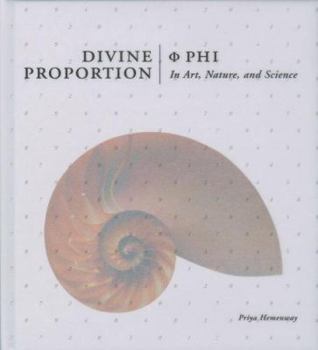Divine Proportion: Phi in Art, Nature, and Science
Select Format
Select Condition 
Book Overview
The Divine Proportion reveals a number of simple patterns: It is seen in the seed patterns of fruits, the family tree of bees, the pyramids of Egypt, Gothic cathedrals, Renaissance paintings, the... This description may be from another edition of this product.
Format:Hardcover
Language:English
ISBN:1402735227
ISBN13:9781402735226
Release Date:October 2005
Publisher:Sterling
Length:208 Pages
Weight:1.88 lbs.
Dimensions:0.9" x 7.8" x 8.5"
Customer Reviews
5 ratings
Nice visual guide to Phi, its history, and its applications
Published by Thriftbooks.com User , 14 years ago
This is a nice book on Phi and the history of the mathematicians and philosophers who played a part in identifying its importance. The book is foremost a non-mathematical visual guide and history book, with lots of drawings and photographs on thick pages, so it would serve nicely as a coffee table book (although it's a bit small). The author delves into the mathematical background of Phi just enough to clearly define what it is and how to derive it. On p. 48, the number itself (1.61803...) is derived from a line segment using basic algebra. On p. 85, the number's relationship to the ratio of two consecutive Fibonacci numbers is shown. Also illustrated are how to create a golden rectangle (p. 84, 106), golden triangle (p. 19), and golden spiral (p. 128) using simple concepts from geometry. What was very enjoyable was the discussion of the history surrounding the number. The author presents the lineage of mathematicians, including Plato, Euclid, Fibonacci, Kepler, and Penrose, and gives short 1-2 page vignettes describing how each one made important discoveries related to Phi. There are excellent illustrations and diagrams on historic concepts like the Platonic solids and how Fibonacci numbers were framed from a story on rabbits. The book is very well organised, with chapters on how Phi relates to physical architecture, nature, science, and mysticism. The latter chapters have very nice descriptions of how Phi intersects with crystallography, tiling, packing, and plant features. Unfortunately, the book is lacking how Phi is concretely applied by man to architecture. The author discusses how Phi could have been used to guide the creation of the Parthenon (using a square-root-of-5 rectangle) but acknowledges that it is still open for debate. There is no discussion on how Phi is used today by contemporary architects and builders. Other parts (e.g. Michaelangelo's use of golden proportion for the Vitrivium Man) could have been developed more fully. As a photographer myself, I would have loved to get more depth on how photography's rule-of-thirds relates to Phi or how painters and sculptures use Phi today. Given that it's not a math book, the book is still recommended since it has great visual content and coverage of Phi's fundamental derivation and history.
awesome gift for myself
Published by Thriftbooks.com User , 14 years ago
my favorite book exactly what i needed - reading this book acted as a therapeutic process and a spiritual awakening great conition timely delivery
Divine Proportion: Phi, Art, Nature, Science
Published by Thriftbooks.com User , 15 years ago
I always return to this book for inspiration. It is written in a clear, concise, yet creative way, with plenty of illustrations to enhance understanding. It will amaze you how often Phi appears in art, architecture, and other adventures of mankind. If you are an artist at heart, like me, this book won't frighten you away even when it dips into the more scientific aspects of Phi. Like the five universal symbols, Phi reminds us of our mortality and universal creativity.
Review of Pryia Hemenway's "DIVINE PROPORTION". PHI.
Published by Thriftbooks.com User , 15 years ago
On my view Pryia's book is a delight to read, making a Synthesis between the artístic, qualitative, impressionistic,poetic,humanistic, psychological, aproach to the study of reality,and the quantitative, mathematic, approach.In fact the designation of"Synthesis"is probably inadequate,one of the more interesting aspects of the book being the discovery of the mathematics present in the beauty of several natural productions as well as in several works of Men and Women.When writing this it came to my mind a few lines of James Joyce's "A Portrait of the Artist as a young man":"Ad pulchritudinem tria requiruntur: integritas, consonantia,claritas",where it is said that beauty (ad pulchritudinem...), besides the impression it causes in the beholder(claritas...) is understandable following three parameters (tria...),easily comprehensible, but not so easy to translate exactly.Pryia's book tries, very bravely,to give a present day, mathematic, version of these words, atributed by Joyce to Thomas Aquinas. I dare to reccomend a reading of the three authors above mentioned. Start with "DIVINE PROPORTION"... Pryia's book
A good basic book
Published by Thriftbooks.com User , 17 years ago
This book gives a good introduction to the concept of the Divine Proportion. The last reviewer seems irritated because this was not the advanced book he expected, but that doesn't diminish the quality of the book. This book is perfect for those who are curious about the Divine Proportion and how it has been used through the ages. The design and illustrations are delightful.





